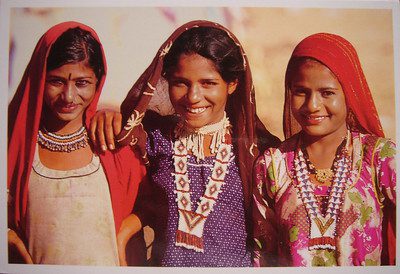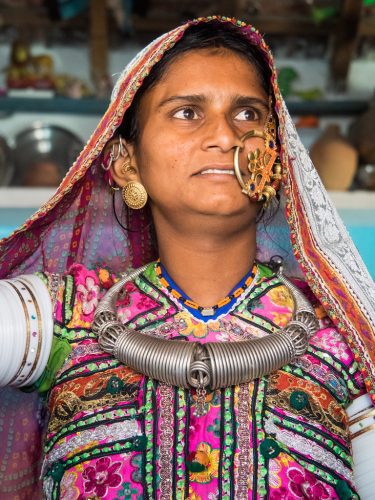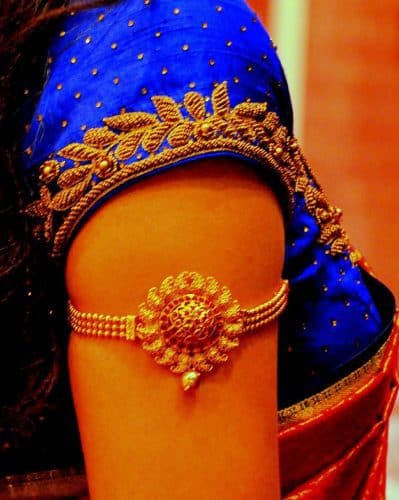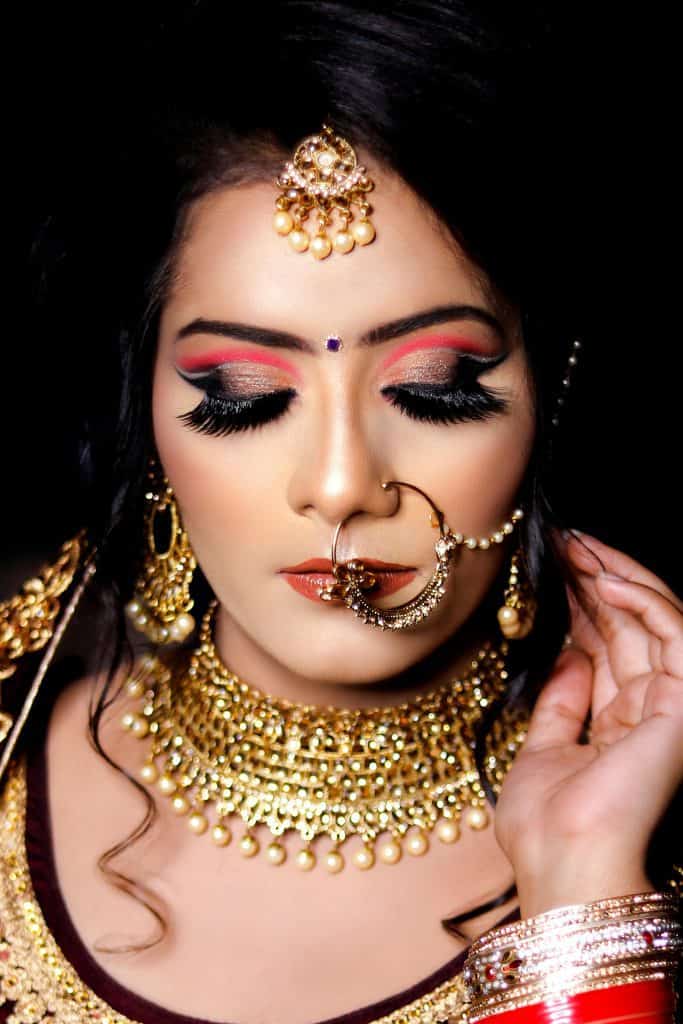Gujarati jewellery is a dazzling tapestry of tradition, artistry, and cultural heritage. Each piece is not just an ornament but a story, meticulously crafted to reflect the rich history and vibrant spirit of Gujarat.

From the intricate design of the Chokha to the radiant shine of the Kundan set, Gujarati wedding jewellery is an ode to elegance and grandeur. These timeless pieces adorn brides, transforming them into visions of grace and beauty, and are often passed down through generations as cherished heirlooms.
Join us as we delve into the mesmerizing world of Gujarati wedding jewellery, where every jewel is a testament to the state’s unparalleled craftsmanship and artistic legacy.
Gujarati jewellery: A long-standing tradition of exquisite jewellery-making
Gujarat, a vibrant state in western India, is renowned for its rich cultural heritage and a long-standing tradition of exquisite jewellery-making. The traditional jewellery of Gujarat showcases a blend of diverse cultural influences, from the intricate designs of Mughal and Rajput styles to the vibrant colours of Gujarati folk art.
Traditional Gujarati jewellery exhibits a stunning diversity among the various communities of the state. Located on the western coast of India, Gujarat boasts a rich cultural tapestry that is vividly reflected in its traditional jewellery and attire. This article delves into the renowned designs of Gujarati jewellery.
The true splendour of traditional jewellery from Gujarat comes to life during festivals like Navratri and Dussehra. During these celebrations, locals don their finest traditional outfits and jewellery, revelling in the festive spirit. The people of Gujarat adorn themselves with lavish jewellery and accessories, showcasing a royal sense of style, artistry, and grace.
Historical Background
Gujarat’s jewellery-making tradition is deeply rooted in ancient history, tracing back to the Indus Valley Civilization. Archaeological excavations in sites like Lothal and Dholavira have unearthed an array of intricate jewellery pieces, including beads, necklaces, and bangles, made from materials like gold, silver, and semi-precious stones.

These findings highlight the advanced craftsmanship and the aesthetic sensibilities of the people of Gujarat even during ancient times. The region’s strategic location as a trading hub further enriched its jewellery heritage, bringing in diverse influences from various cultures, including Persian, Greek, and later, Mughal and Rajput styles.
Cultural Significance
In Gujarati culture, jewellery is more than just an accessory; it is a symbol of social status, religious beliefs, and cultural identity. The traditional jewellery of Gujarat reflects the state’s diverse cultural influences and is deeply intertwined with its customs and traditions.
Artisanal Skills in Jewellery from Gujarat
The creation of traditional jewellery from Gujarat showcases meticulous craftsmanship, blending traditional methods with modern adaptations. Traditional techniques such as Kundan, Meenakari, and Jadtar remain central. Kundan involves setting gemstones with gold foil, while Meenakari adds vibrant enamel designs. Jadtar jewellery, with uncut diamonds set in gold, requires precision and skill.
Modern adaptations have introduced laser cutting and fusion designs, enhancing detail and integrating contemporary styles. Artisans now blend traditional motifs with modern aesthetics, catering to evolving tastes without compromising heritage. This blend of old and new ensures that the jewellery remains both timeless and trendy, celebrating cultural legacy while embracing innovation.
Each piece, whether a bridal adornment or a statement accessory, reflects the artisans’ dedication to excellence and their ability to adapt traditional techniques for today’s world.
These pieces are not merely adornments but also symbols of the wearer’s social status, religious beliefs, and cultural identity.
Iconic Ornament Pieces of Jewellery from Gujarat
Patla: Patla is a traditional waistband worn by women in Gujarat, typically crafted from gold and adorned with precious stones like diamonds, rubies, and emeralds. This ornate accessory encircles the waist, symbolizing wealth and status. Patla is prominently featured during special occasions such as weddings and festivals, showcasing the wearer’s elegance and cultural heritage. Its intricate design and luxurious materials make it a cherished piece of heritage jewellery.
Kandora/Kardhani: Kandora, is among waistband Gujarati jewellery designs jewellery cherished by women in Gujarat that showcases intricate craftsmanship and cultural elegance. Crafted from gold and adorned with precious stones like diamonds, rubies, and emeralds, this beautiful piece features a broad band secured with a hook or clasp. Delicate chains and tassels dangle gracefully from the band, enhancing its allure, while small pendants like bells or coins add a charming jingling sound.
In Gujarati culture, Gujarati bridal jewellery like the Kandora is more than just an accessory; it symbolizes wealth, status, and femininity. Worn on special occasions such as weddings, festivals, and religious ceremonies, it holds a place of honour. The creation of a Kandora demands exceptional skill and expertise, reflecting the dedication and artistry of its makers.
Rakhdi or Borla: Another beloved jewellery item is the “Borla” or “Rakhdi” – a stunning maang tikka traditionally worn by brides on their wedding day. This elaborate forehead ornament, crafted from gold or silver, beautifully adorns the bride’s forehead. Artisans embellish it with pearls, kundan work, and vibrant gemstones, creating a piece that is both exquisite and culturally significant.
Hansuli: The Hansuli, a traditional Gujarati neck ornament, is renowned for its elegant crescent shape. Crafted from gold or silver, it often features intricate engravings and embellishments with gemstones like rubies, emeralds, and diamonds. As a staple in traditional jewellery sets, the Hansuli symbolizes wealth and cultural heritage. Frequently worn during significant ceremonies and passed down as a family heirloom, this exquisite piece reflects the rich craftsmanship and enduring beauty of jewellery from this state.
Bajubandh: The Baju Bandh, a traditional armlet cherished by women in Gujarat epitomizes elegance and grace. Crafted from gold and adorned with precious stones like diamonds, rubies, and emeralds, this exquisite piece is worn on the upper arm. It symbolizes femininity and beauty, adding a touch of splendour to the wearer. Baju Bandh remains a treasured adornment in Gujarati culture.

Chandlo: The Chandlo, a cherished jewellery heirloom, is a stunning forehead ornament symbolizing elegance and tradition. This intricate piece typically features a central gemstone, often a ruby or emerald, surrounded by delicate patterns crafted in gold or silver. The detailed designs and vibrant stones reflect skilled craftsmanship. Worn during weddings and cultural ceremonies, the Chandlo not only enhances beauty but also signifies cultural heritage, making it a treasured family heirloom.
Damani: Drop earrings are a versatile accessory, perfect for any occasion, whether it’s a night out or a formal event. These earrings have a decorative piece that hangs below the earlobe, giving them a graceful and elegant appearance. They come in various styles, such as chandelier earrings, teardrop earrings, and statement drop earrings, offering a wide range of options to suit different tastes and outfits.
Kundan Butti: Kundan Butti is a traditional jewellery piece that originated in Rajasthan and is also popular in Gujarat. The gemstones are set in a wax mould and then placed in a frame. Typically worn as a necklace or earrings, Kundan Butti is revered as a symbol of beauty and elegance, enhancing any traditional attire.
Todi: Todi is a traditional toe ring worn by women in Gujarat, typically made of silver and worn on the second toe. It symbolizes marital status and is commonly gifted to brides on their wedding day. Beyond its cultural significance, Todi is also believed to have medicinal properties, offering health benefits to the wearer. This meaningful ornament blends tradition with wellness, making it a cherished part of Gujarati bridal attire.
Nathini: Nathini, popular among Gujarati and Rajasthani women, features a large golden ring with a chain that attaches to the hair. It is often decorated with gemstones like Rose Quartz, Amethyst, or Diamond. The nose pin, or Kil, is typically made of silver. Some women opt for a small stud, while others prefer a larger nose pin adorned with intricate floral designs, making this piece both versatile and elegant.
Mattha Patti or Gujarati Damini: A Gujarati bride also wears this traditional Damini at her wedding. The Damini includes a maang tikka for the forehead and side strings that tie into the hair. It features several gold chains linked together, adorned with captivating motifs encrusted with rubies and emeralds. This headpiece, worn on the forehead with its side loops secured at the sides and centre, adds an elegant touch to bridal attire.
Pachheli: The Pachheli is a distinctive earring traditionally worn by men in Gujarat. Featuring a circular disc design, these ornaments are often embellished with gemstones or pearls, adding a hint of sophistication to the wearer’s appearance. Pachheli earrings are more than just accessories; they carry the weight of heritage, frequently passed down through generations as cherished family heirlooms, blending elegance with tradition.
Kanti: Kanti is a traditional Gujarati choker-style necklace that sits closely around the neck, radiating elegance and cultural richness. The elaborate designs reflect skilled craftsmanship, making it a statement piece worn during special occasions like weddings and festivals. Kanti not only enhances the wearer’s beauty but also symbolizes tradition and status, making it a cherished addition to any jewellery collection.
Contemporary Adaptations
Modern designers are skillfully blending traditional elements with contemporary aesthetics, creating pieces that appeal to today’s fashion-conscious consumers. They incorporate traditional motifs, like peacocks and lotus flowers, into sleek, minimalist designs, and use modern materials such as white gold and diamonds alongside traditional gold and enamel work. This fusion results in jewellery that maintains its cultural roots while appealing to modern tastes.
The influence of celebrities and fashion influencers has significantly elevated the global profile of traditional jewellery. Bollywood stars and international celebrities often adorn Gujarati-inspired pieces at red-carpet events, weddings, and fashion editorials. These high-profile endorsements have brought global attention to craftsmanship and unique designs, making it a sought-after choice for luxury fashion.

Social media platforms amplify this visibility, with influencers showcasing how these traditional pieces can be styled in contemporary ways, appealing to a younger, global audience. This trend not only boosts the popularity of traditional jewellery designs but also supports the artisans and preserves the cultural legacy of Gujarat’s rich jewellery-making tradition.
By embracing innovation while honouring heritage, jewellery from Gujerat stands as a symbol of enduring beauty and craftsmanship, captivating generations with its timeless elegance. The intricate designs and vibrant aesthetics of jewellery making from Gujarat have captivated admirers for centuries, and today, they continue to shine on a global stage.
Read more: Latest



